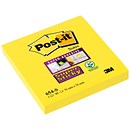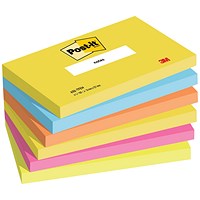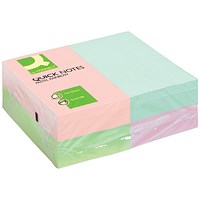Post-it Notes
Very few stationery products attain iconic status. The Post-it Note is one such icon.
“Post-it Note” is one of those proprietary names like Coke, Kleenex and Hoover that has become a generic. The Post-it Note has inspired, and has been a medium of, artistic works.
Post-it Notes are like knives and forks, remote controls, computer mice: As objects they just fit with the way we humans organise and navigate reality. Post-it Notes allow us to turn the world into one big three-dimensional user interface. We can write to-do lists, foreign language words and sweet nothings on Post-it Notes and then stick them wherever we please. Both sender and receiver (often the same person when it comes to Post-it Notes) naturally understand the language of this (optimally) sticky medium and what's more the grammar and syntax of this language involves the world of objects: the document, the door, the computer monitor, even the sandwich (“Hands off!”).
Paperstone offers a staggering range of Post-it Note products so just click on a picture above to start exploring this quasi-mythological world. You may find it difficult to settle on one product as each ocean you explore reveals previously uncharted Post-it Note islands and cities.
Types of Post-it Notes
- Standard sticky notes. Normal sticky notes which can be stuck to most surfaces and removed cleanly.
- Ruled notes. Post-its with feint ruled lines for easy writing.
- Super sticky notes. Contain a stronger, “stickier” adhesive so they stick just about anywhere.
- Note cubes. Lots more sheets per cube.
- Z-notes. Post-its in a concertina specifically designed for dispensers.
- Shaped notes. Novelty shaped notes for different messages.
- Post-it index. Sticky bookmarks for organisation and colour coding.
The Post-it Note in History
In the revolutionary year of 1968, when French students and workers struck fear into the heart of the de Gaulle government and the Prague Spring reforms of Alexander Dubcek prompted a Warsaw Pact invasion, a scientist at multinational 3M, Dr. Spencer Silver, quietly developed a “low-tack”, repositionable pressure sensitive adhesive. He tried to promote his invention through 3M but without much success and it was not until 1974, when a 3M colleague of Silver's, Art Fry, used the adhesive on pieces of paper to bookmark his hymn book (he sang in his church choir at the weekend), that the wheels of Post-it Note history started rolling.
Now a convert, Fry set about trying to manufacture Post-it Notes on a grand scale and in 1977, overcoming initial operational difficulties, he managed to produce enough Post-it Notes to supply 3M's corporate headquarters. 3M employees quickly became hooked but it took a further three years of test marketing and sampling blitzes for Post-it Notes to be introduced across America in 1980. The following year Post-it Notes reached Canada and Europe. The world would never be the same again.

























